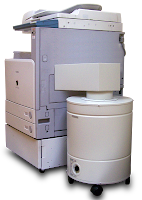 |
| Toxins released in oil and gas production can affect human health, authorities warn. |
Cost-effective, flexible standards rely on operators' ability to capture and sell natural gas that currently escapes, threatens air quality
The U.S. Environmental Protection Agency (EPA) on Thursday proposed standards to reduce harmful air pollution from oil and gas drilling operations.
The U.S. Environmental Protection Agency (EPA) on Thursday proposed standards to reduce harmful air pollution from oil and gas drilling operations.
These proposed updated standards - which are being issued in response to a court order - would rely on cost-effective existing technologies to reduce emissions that contribute to smog pollution and can cause cancer while supporting the administration’s priority of continuing to expand safe and responsible domestic oil and gas production.
The standards would leverage operators' ability to capture and sell natural gas that currently escapes into the air, resulting in more efficient operations while reducing harmful emissions that can impact air quality in surrounding areas and nearby states.
"This administration has been clear that natural gas is a key component of our clean energy future, and the steps announced today will help ensure responsible production of this domestic energy source," said Gina McCarthy, assistant administrator for EPA's Office of Air and Radiation.
"This administration has been clear that natural gas is a key component of our clean energy future, and the steps announced today will help ensure responsible production of this domestic energy source," said Gina McCarthy, assistant administrator for EPA's Office of Air and Radiation.
"Reducing these emissions will help cut toxic pollution that can increase cancer risks and smog that can cause asthma attacks and premature death - all while giving these operators additional product to bring to market.”
The proposal would cut smog-forming volatile organic compound (VOC) emissions from several types of processes and equipment used in the oil and gas industry, including a 95 percent reduction in VOCs emitted during the completion of new and modified hydraulically fractured wells.
This dramatic reduction would largely be accomplished by capturing natural gas that currently escapes to the air and making that gas available for sale through technologies and processes already in use by several companies and required in some states.
Natural gas production in the U.S. is growing, with more than 25,000 new and existing wells fractured or re-fractured each year. The VOC reductions in the proposal are expected to help reduce ozone nonattainment problems in many areas where oil and gas production occurs.
Natural gas production in the U.S. is growing, with more than 25,000 new and existing wells fractured or re-fractured each year. The VOC reductions in the proposal are expected to help reduce ozone nonattainment problems in many areas where oil and gas production occurs.
In addition, the VOC reductions would yield a significant environmental benefit by reducing methane emissions from new and modified wells. Methane, the primary constituent of natural gas, is a potent greenhouse gas - more than 20 times more potent than carbon dioxide.
The proposed changes also would reduce cancer risks from emissions of several air toxics, including benzene.
EPA’s analysis of the proposed changes, which also include requirements for storage tanks and other equipment, show they are highly cost-effective, with a net savings to the industry of tens of millions of dollars annually from the value of natural gas that would no longer escape to the air.
EPA’s analysis of the proposed changes, which also include requirements for storage tanks and other equipment, show they are highly cost-effective, with a net savings to the industry of tens of millions of dollars annually from the value of natural gas that would no longer escape to the air.
The proposal includes reviews of four air regulations for the oil and natural gas industry as required by the Clean Air Act: a new source performance standard for VOCs from equipment leaks at gas processing plants; a new source performance standard for sulfur dioxide emissions from gas processing plants; an air toxics standard for oil and natural gas production; and an air toxics standard for natural gas transmission and storage.
More information: http://epa.gov/airquality/oilandgas/
More information: http://epa.gov/airquality/oilandgas/
For improved indoor air quality and reduced exposure to VOCs, consider using an industrial-strength air cleaner with activated carbon and HEPA. Contact Electrocorp for more information.


























